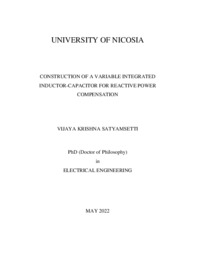- Satyamsetti, VijayaKrishna
- School of Sciences and Engineering
- Department of Engineering
- May 2022
- English
- 71 pages
- Michaelides, Andreas | Hadjiantonis, Antonis | Hirodontis, Stelios
- Foil wound capacitors and inductors | Integrated inductor capacitor | Power factor correction | Power quality and reactive power compensation
- Sciences and Engineering -- Engineering
-
-
This thesis presents an integrated inductor-capacitor wound from aluminum/polyester foils and examines its suitability to provide variable reactive power for compensation in low voltage power systems. Explaining the functional concept of this integrated component shows how its terminal impedance can be adjusted to be either capacitive or inductive. A 15 kVAR prototype integrated component is wound. Measured technical parameters of the pilot model like capacitance, inductance and resistance match satisfactorily respective values in the calculation scheme of the preceding components’ design, thus verifying its dual character.
The next stage enabling qualified analysis of this component is the derivation of its equivalent circuit. The integrated inductor-capacitor wound from aluminum and polyester foils measures constant parameters and hence provides the possibility for limited experimentation. Employing, however, the equivalent circuit, instead of the integrated inductor-capacitor, displaying the same operational behavior but constructed from discrete components as resistors, inductors and capacitors widely available in the market in big variety and easily exchangeable in the circuit provides multiple and diverse experimental possibilities. This may avoid winding components of various parameters with materials of different sizes requiring particular winding equipment, thus exceeding the current scope of experimentation. Finally, the significance of presenting the integrated inductor-capacitor via an equivalent is the possibility to express its terminal impedance as a function of its technical parameters, R, L and C.
The realized equivalent circuit, constructed from discrete components can provide throughout a considerable range of capacitive up to inductive reactive power. In the experimental part to follow, a specially constructed circuit replicating the equivalent circuit is regulated by a variable resistor at the load terminals 2-4 in order to provide the exact capacitive reactive power required to compensate the phase shift in the system caused by a single phase induction motor. The same circuit provides, during further experimentation via regulation of the variable resistor, inductive reactive power thus compensating the leading phase shift of the simulated capacitive load. Adjusting the circuit’s terminal impedance is being achieved via a variable resistor. Considerable losses, converted in the equivalent circuit when regulated with variable resistor in order to provide the required reactive power, are of major concern. Because of this the possibility is being examined to regulate the equivalent circuit’s impedance with an air wound inductor. This variable inductor functions on the principle of mutual inductance.
In further measurements documenting the ability of the actual foil wound component to perform automatic compensation, the reactive power of a 1.2 kW, 230 V induction motor is compensated by the initial constructed pilot model, the latter being regulated to provide the necessary capacitive reactive power via the variable inductor. Continuous monitoring of the system constituted by the induction motor and the integrated component assess the phase and consequently regulates automatically the component’s terminal impedance thus maintaining unity power factor in the system, despite varying load. Extended experimentation indicates reasonable prospects for the integrated component to provide VAR compensation.
-
Construction of a Variable Integrated Inductor-Capacitor for Reactive Power Compensation
Main Files
| Type | Location | Link |
|---|---|---|
| dissertation | [More information] |


